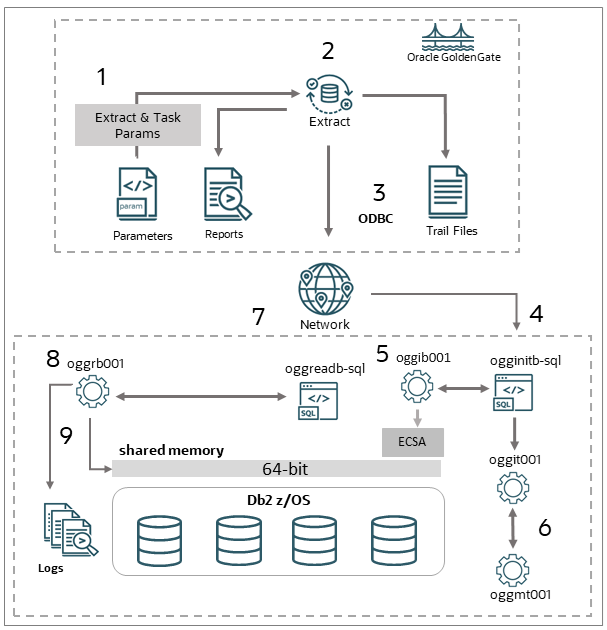Install Extract Components on Db2 z/OS
-
External authorized programs include the following:
-
oggib001– Initialization and utility program -
oggrb001– Log read program functionality -
oggmt001– Stand-alone program that monitors ECSA and 64-bit memory oggjt001– Setup program for theoggmt001startup JCL run fromoggib001program-
oggfr001– Utility for use by a DBA under guidance from Oracle Support
-
-
SQL stored procedure and function templates are included in the SQL script
zOS_OGG_Setup_Template.sqlwith theOGGINITBandOGGREADB SQL. -
JCL procedure,
oggtask.jcl
Note:
The external names for the SQL and JCL name values are the default, which you can edit and update. This process is discussed in the subsequent sections.
The Replication Process for Db2 z/OS Extract figure illustrates the replication process for the Db2 z/OS Extract and its mainframe components.
Figure 7-1 Replication Process for Db2 z/OS Extract

-
Extract reads the parameters, including the JCL parameters, from the parameter file created during installation.
-
Extract reports the startup information and prepares to write the trail files.
-
ODBC is used to gather information from the Db2 database and start replication.
-
The
OGGINITBSQL stored procedure starts to prepare the shared memory and to gather other data needed for replication. -
The
OGGIB001external program called by the SQL stored procedure starts the memory monitor task using theOGGJT001job setup program. -
The
OGGMT001memory monitor task starts monitoring the ECSA and 64-bit shared memory. -
The
OGGREADBSQL Function calls the external programOGGRB001. -
The
OGGRB001external program repeatedly calls the Db2 log read program to create a result set that returns 1 to many log record buffers to the Extract. -
When a log record result set is complete,
OGGRB001ends after sending the result set to the Extract.
Extract repeats steps 7 to 9 until shut down or abnormal
termination. If the memory task fails to start, OGGIB001 program
returns a flag indicating there was a JCL error or setup issue and Extract begins to
manage its memory. If the memory task starts properly, the memory task tests
constantly changing fields in the 48-byte ECSA shared memory. These fields stop
changing if the Extract terminates for any reason. At that point, the memory manager
waits in case the Extract or network is slow and releases the memory before shutting
down after a configured time limit.
Note:
The oggifi0001 schema name is configurable using the
TRANLOGOPTIONS REMOTESCHEMA schemaname Extract
parameter. The procedure and function names, OGGINITB and
OGGREADB, in the template are not configurable. You can
rename each external name in the scripts and the PDSE if the script names and
the PDSE object names match. Changing these names is part of the procedure that
allows migration to new versions or if specific naming procedures must be
adhered to on Db2 z/OS.
The following table contains a check list of components that you may wish to edit and/or update:
Table 7-2 List of Editable Components
| Component | From | Rename | Where |
|---|---|---|---|
|
|
tar file |
authorized PDSE |
|
|
|
tar file |
authorized PDSE |
|
|
|
tar file |
authorized PDSE & proc library |
|
|
|
tar file |
authorized PDSE & Extract parm |
|
|
|
tar file |
procedure library & Extract parm |
|
|
proclib |
MVS |
add Extract parm if needed |
|
|
step libraries |
MVS |
WLM and |
|
|
remoteschema |
|
||
|
WLM name |
MVS |
|
|
|
external program |
|
Note:
Remember to perform all these steps after every new patch installation.